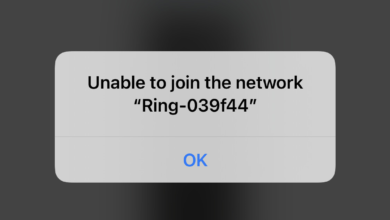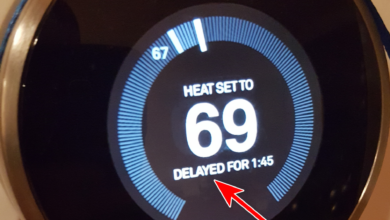Your Nest Thermostat Stopped Cooling? Don’t Worry, Try this!
The Nest thermostat ceases cooling due to either hardware problems or some conflicting in-app configurations that may not have been initialized properly. Most of the time, the issues are related to software modules and features such as schedules and home-away assists.
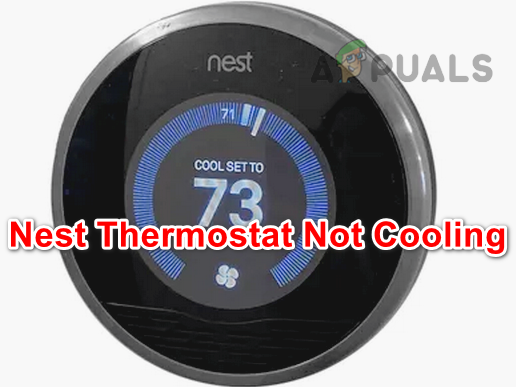
Common Scenarios when the Nest Thermostat Does not Cool
Firmware update: A problem is observed across various generations and variants of Nest thermostats, where the thermostat or app may indicate cooling or precooling, but instead, hot air is being released from the unit. This issue can be triggered by a firmware update, causing a previously functional Nest thermostat to stop cooling.
Air conditioning option not shown: Some people may find that only the heating option is available on the thermostat, and the AC unit is not shown as a cooling choice. This problem is not limited to specific types of equipment, as it occurs with various manufacturers, including heat pumps, AC units, gas or electric systems, and forced air systems.
Only the heating option works or the thermostat goes offline: Interestingly, in certain cases, the heating option functions correctly despite the cooling problem. Customers have reported instances where the AC power turns on briefly and then switches off. Additionally, there are occurrences where the thermostat goes offline. The problem may arise with both new installations and previously well-functioning thermostats. Some people have experienced this issue after switching the thermostat from heat mode to cool mode after a season change.
Troubleshooting Pre-requisites
- Make sure none of the circuit breakers in your setup has tripped.
- Check if increasing or decreasing the temperature impacts the cooling.
How to Fix Nest Thermostat Not Cooling?
If you are indeed experiencing a hardware problem and your device is non-functional, you will have to ultimately either claim a warranty or get it replaced. In case of bugs & glitches that might be limiting your cooling, here are some steps you can take.
1. Restart the Nest Thermostat and Equipment
The Nest thermostat will not send a required cooling signal to the cooling unit if the thermostat modules are in an error state. Resultantly, the cooling unit will not power on and thus will not cool the air. To address this issue, restart the Nest Thermostat and your equipment.
- Press and hold the ring on the Nest thermostat.

Restart the Nest Thermostat - Wait till the screen turns off (it may take around 10 seconds) and release the ring.
- Wait for a minute and press the ring again.
- Once the Nest logo disappears from the thermostat screen, check if the cooling problem is solved.
- If not, manually restart your cooling system and check if that solves the problem.
2. Verify the Wiring Configurations
If the wiring configurations on the Nest thermostat are not properly verified, the thermostat won’t be able to authenticate whether it can control the cooling unit. As a result, it will not send the necessary powering-on signal to activate the cooling system.
In such a case, verifying your wiring configurations on the thermostat will do the trick.
- On the Nest thermostat, go to Settings > Equipment > Pro Setup.
- On the warning screen, tap on Continue and check if a wire is showing a yellow wedge.

Open Pro Setup in the Nest Thermostat Settings - If a wire is showing a yellow wedge, select that wire on the thermostat and verify the wire connection is correct. It will turn green from yellow. Check each wire and make sure no wire is showing a yellow wedge.

Verify Wiring on the Nest Thermostat - Once done and all the wires are showing green wedges, exit the Pro Setup and check if the cooling problem is solved.
- If the problem persists, ensure that you have correctly selected the type of heat or cool source on your thermostat, whether it’s electric or gas.
3. Change the Orientation Settings of the Heat Pump
The heat pump utilizes a reversing valve to alternate between hot and cool modes. The OB setting, also known as the Orientation setting, allows you to configure the heat pump type on the thermostat. If your cooling system is blowing out warm air when you’ve set the Nest thermostat to cool, it indicates an incorrect orientation setting.
Here, changing the orientation setting on the Nest thermostat will rectify the issue.
- On the Nest thermostat, launch Settings and go to Equipment.
- Tap on Continue and select Heat Pump.
- If the O setting is selected, tap on B and if the B setting is selected, tap on O. You can also change these settings on the Nest app.
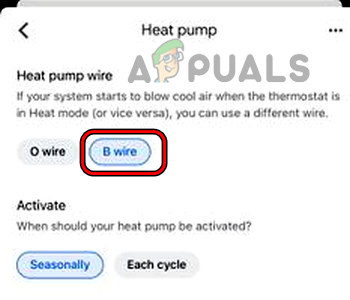
Change the Heat Pump Orientation in the Nest App - Check if the cooling problem is solved.
4. Reset Your Schedule to the Defaults
If the learned or manually created schedule of the thermostat becomes invalid, it will be unable to send the cooling signal to the cooling system, resulting in the cooling issue at hand. In this situation, resetting the schedule back to its default settings will solve the problem.
- On the Nest thermostat, go to Settings > Reset.
- Select Schedule and once done, create a new schedule. Verify if the problem is solved.
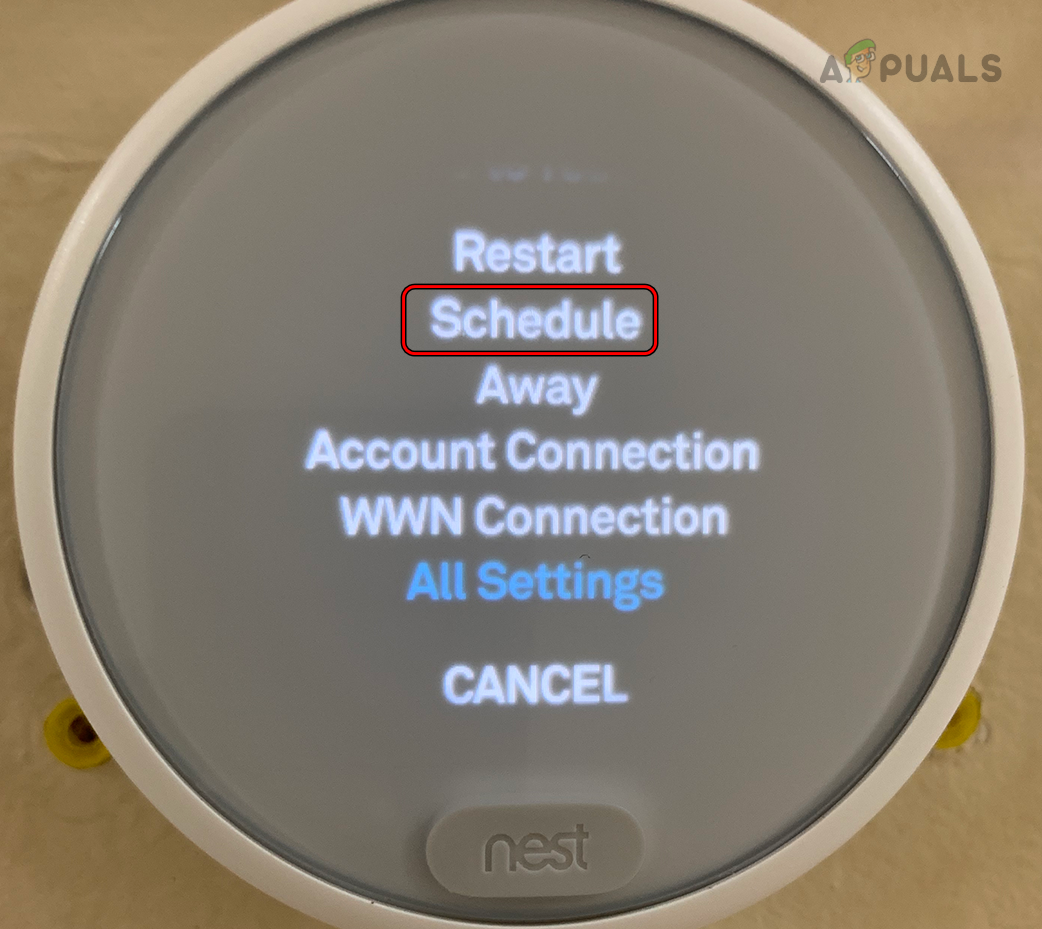
Reset the Schedule on the Nest Thermostat
5. Disable Home-Away Assist
The Home-Away Assist feature enables the thermostat to cool the area when you are present or about to arrive, and it reduces cooling when you are away to save energy. However, if there is a malfunction in the location modules of your phone, the thermostat will not detect your presence at home and consequently fail to activate the cooling.
To address this issue, disable the Home-Away Assist feature. This way, the thermostat won’t rely on your phone’s location and will follow a different cooling pattern.
- Launch the Nest app and go to Settings > Home-Away Assist.
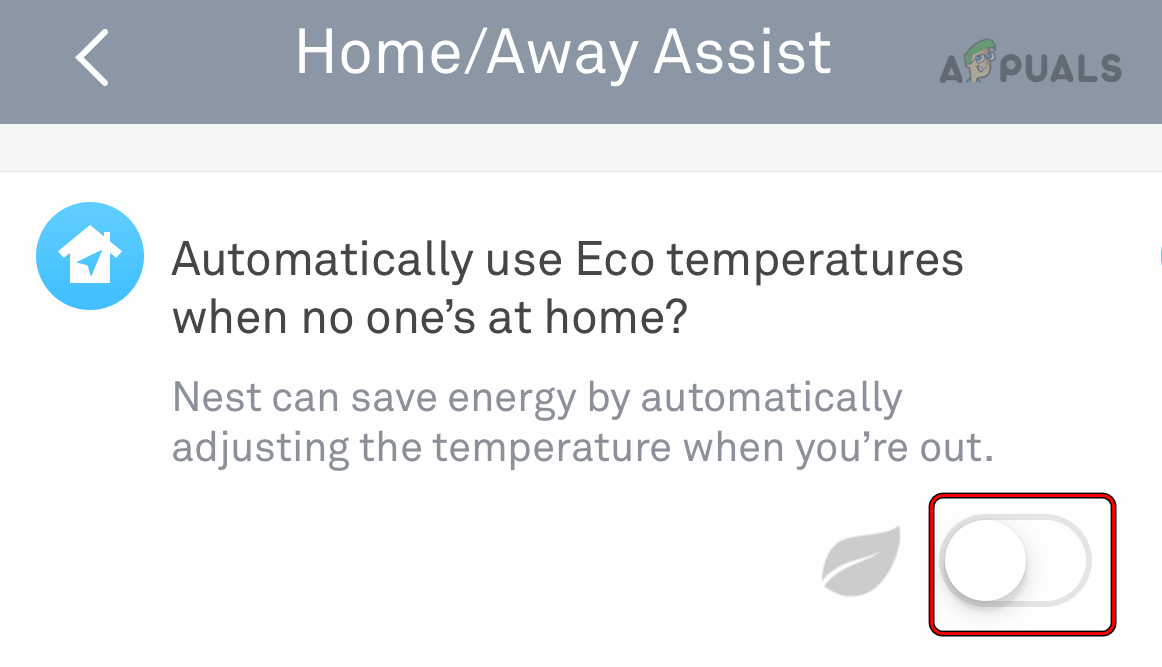
Disable Home-Away Assist in the Nest App - Disable it and see if the problem is solved.
- If so, then enable back the feature, and under Home-Away Assist, open What Decides If You’re Home.
- Disable the Nest Thermostat under Products and tap on your current device (such as your phone).

Disable the Nest Thermostat Under Home/Away Assist Products - Set the Location permission to Always and see if the issue does not return. If it does, then you may disable the Home-Away Assist till the problem is solved permanently. Also, you can manually switch your location to the Home in the app setting if you do not want to disable Home-Away Assist.
6. Disable Auto-Schedule
The Nest thermostat utilizes the Auto Schedule feature to automatically cool down your home based on your daily routine. However, if you deviate from your regular schedule or the Auto Schedule feature malfunctions, the cooling system will cease to function properly.
This can be fixed by disabling Auto Schedule.
- Launch the Nest app and select the problematic thermostat.
- Go to Settings > Auto-Schedule.
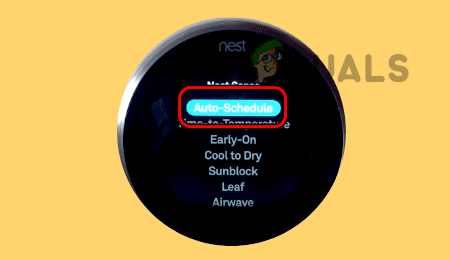
Disable Auto Schedule on the Nest Thermostat - Disable it and see if the cooling problem is solved.
7. Disable Safety Temperature
To prevent your home pipes from freezing or your home from overheating, the Nest thermostat comes equipped with the Safety Temperatures feature. This feature ensures that the thermostat will activate or deactivate cooling or heating, even if the thermostat is off when your home reaches a specific temperature threshold.
However, we’ve seen issues where this safety feature fails to initialize property and as a result, cooling doesn’t happen. To solve this problem, disable the Safety Temperature feature on the thermostat.
- On the Nest thermostat, launch Settings and go to Safety Temp. You can also do these steps on the Nest app.
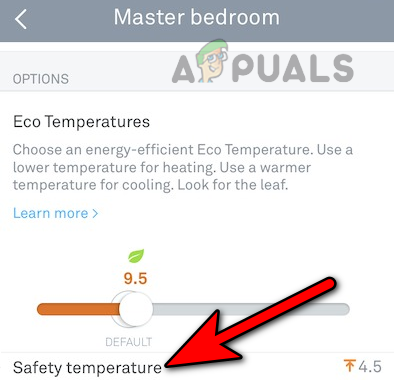
Disable Safety Temperature on the Nest Thermostat by Using the Nest App - Set it to off and observe if the cooling operation starts to work correctly.
- If the cooling appears to be functioning properly after disabling Safety Temp, wait for one to two hours, and then re-enable the Safety Temp feature.
- Monitor the cooling system for any recurring issues. If the problem does not occur again, you can continue using the thermostat with the Safety Temp feature enabled.
8. Reset the Nest Thermostat to the Factory Defaults
If the core firmware modules of the Nest Thermostat are damaged, the unit will be unable to initialize cooling, leading to a lack of cool air from your cooling system. To rectify this issue, perform a factory reset on the Nest Thermostat.
Be aware that this action will erase any learned patterns or schedules that the thermostat has accumulated. If you wish to preserve the current configurations or wiring, access the thermostat’s Settings and navigate to Equipment to make a note of them beforehand.
- Launch the Nest app and open its menu.
- Go to Settings > Security.
- Remove the Nest thermostat in question.
- On the Nest thermostat, launch Settings and go to Reset.
- Select All Settings and wait till the process completes.

Reset All Settings on the Nest Thermostat - Set up the thermostat as you have done the first time and see if the problem is solved.
9. Reinstall the Nest or Google Home App
The Nest thermostat is tightly linked to the Nest app. If the latest update installation has damaged the core components of the app, the app will fail to convey the required commands to the thermostat properly and thus cause the issue.
Reinstalling the Nest app after resetting the Nest thermostat will get the job done.
- Reset the Nest thermostat after removing it from your account (as discussed above).
- On Android, go to Settings > Applications > Google Nest app or Google Home app. Uninstall it. For iOS, tap and hold the app’s icon and select Remove App.
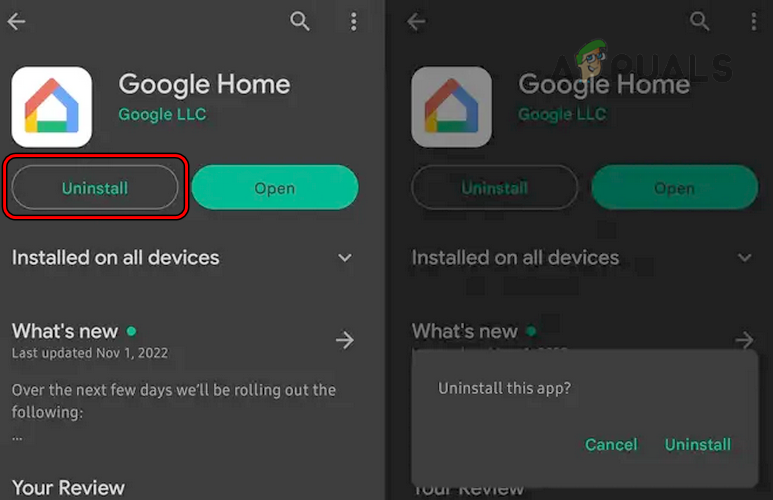
Uninstall the Google Home App - Restart your phone and reinstall the Nest app.
- Launch the app and use another Google account with the app.
- Configure the Nest thermostat but disable the following settings during the process:
Early on Cool to Dry Eco Mode
- Save the configurations and see if the thermostat is working correctly.
10. Connect the C or Common Wire
Until now, we were trying to solve the problem on a software basis but now, we have to get our hands dirty. The last step in troubleshooting a cooling issue when using a Nest thermostat is checking and correcting its wiring. But as that is too specific in each case, we will just be limited to connecting the C or common wire.
We will exclusively focus on providing general guidelines for connecting the C wire, as they can vary depending on the specific products and equipment involved. To ensure successful implementation in your unique scenario, you may need to conduct further research and dig deeper into the details.
- Make sure to connect the C or common wire on both ends, i.e., at the thermostat and the cooling/heating system. While some may consider the C wire unnecessary, not connecting it has often been identified as the main cause of the issue in many instances.
In some cases, you may need to use a C-wire adapter. You can also charge the thermostat if a C wire is not available in your configurations.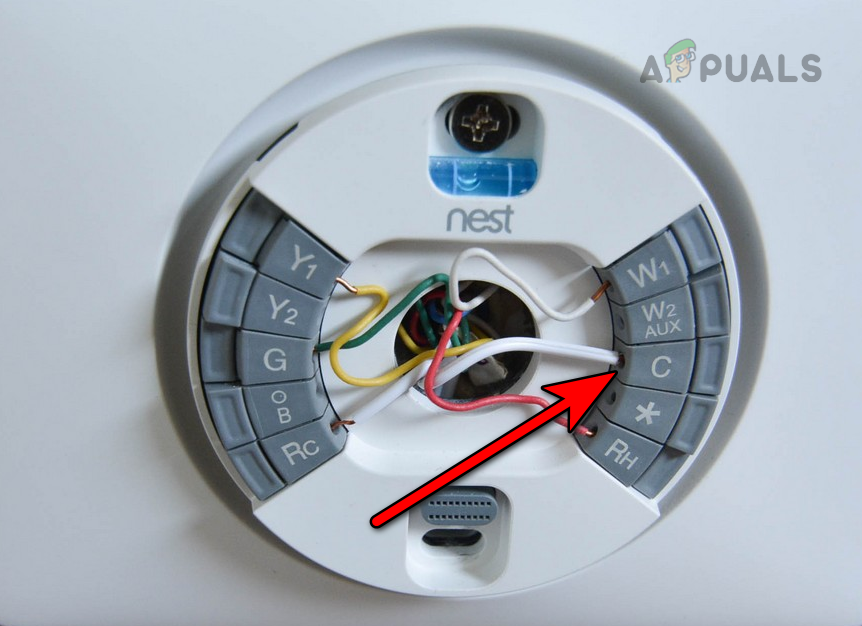
Connect C Wire in the Nest Thermostat - Once done, hopefully, the Nest thermostat will be operating correctly.
If the issue is still there and another thermostat is available with you, replace the problematic Nest thermostat with it and see if the cooling problem is solved. If the cooling starts to work, then the thermostat is faulty, otherwise, the issue lies in your equipment.
If you identify that the problem is related to the thermostat but it is out of warranty, check its terminals for any visible damage. If it is under warranty, contact Google Support and request a replacement. The support may guide you on the wiring and you may need to ensure your setup meets those instructions.
If the issue is equipment related, then there can be various causes for this, such as a blown capacitor in the fan unit, a blocked drainage pipe, converter issues in the HVAC unit, or problems with pressure within the unit, etc. and you will need the help of repair service to identify and rectify it. If the issue is due to pressure in the unit, make sure there is no leakage in your cooling or heating system before refilling it.
 Reviewed by
Reviewed by 



